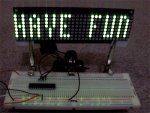This PICAXE-28X1 code was developed to drive a cheap 32x8 LED dot-matrix display from Sure Electronics - the driver used is an HT1632 from Holtek Semiconductor.
The program displays a continuously scrolling message (up to 63 characters long) on the display (click here for a video). The code is not especially complicated, but as it can be rather frustrating trying to get devices responding at all initially I thought it might be useful to have some sample code!
The program displays a continuously scrolling message (up to 63 characters long) on the display (click here for a video). The code is not especially complicated, but as it can be rather frustrating trying to get devices responding at all initially I thought it might be useful to have some sample code!
Attachments
-
58.6 KB Views: 376
-
9.9 KB Views: 444
Last edited:

